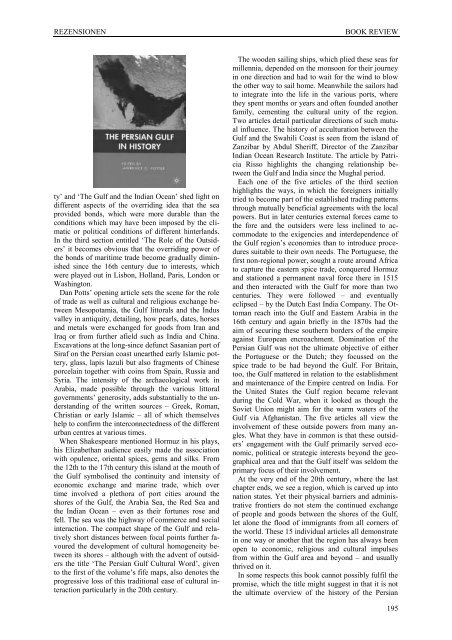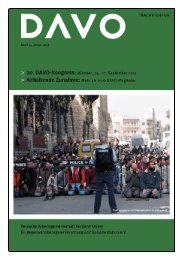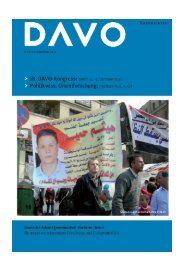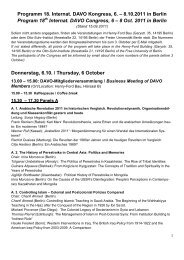4 Dissertationen und Habilita- tionen / Dissertations and Habilitations
4 Dissertationen und Habilita- tionen / Dissertations and Habilitations
4 Dissertationen und Habilita- tionen / Dissertations and Habilitations
Sie wollen auch ein ePaper? Erhöhen Sie die Reichweite Ihrer Titel.
YUMPU macht aus Druck-PDFs automatisch weboptimierte ePaper, die Google liebt.
REZENSIONEN BOOK REVIEW<br />
ty’ <strong>and</strong> ‘The Gulf <strong>and</strong> the Indian Ocean’ shed light on<br />
different aspects of the overriding idea that the sea<br />
provided bonds, which were more durable than the<br />
conditions which may have been imposed by the climatic<br />
or political conditions of different hinterl<strong>and</strong>s.<br />
In the third section entitled ‘The Role of the Outsiders’<br />
it becomes obvious that the overriding power of<br />
the bonds of maritime trade become gradually diminished<br />
since the 16th century due to interests, which<br />
were played out in Lisbon, Holl<strong>and</strong>, Paris, London or<br />
Washington.<br />
Dan Potts’ opening article sets the scene for the role<br />
of trade as well as cultural <strong>and</strong> religious exchange between<br />
Mesopotamia, the Gulf littorals <strong>and</strong> the Indus<br />
valley in antiquity, detailing, how pearls, dates, horses<br />
<strong>and</strong> metals were exchanged for goods from Iran <strong>and</strong><br />
Iraq or from further afield such as India <strong>and</strong> China.<br />
Excavations at the long-since defunct Sasanian port of<br />
Siraf on the Persian coast unearthed early Islamic pottery,<br />
glass, lapis lazuli but also fragments of Chinese<br />
porcelain together with coins from Spain, Russia <strong>and</strong><br />
Syria. The intensity of the archaeological work in<br />
Arabia, made possible through the various littoral<br />
governments’ generosity, adds substantially to the <strong>und</strong>erst<strong>and</strong>ing<br />
of the written sources – Greek, Roman,<br />
Christian or early Islamic – all of which themselves<br />
help to confirm the interconnectedness of the different<br />
urban centres at various times.<br />
When Shakespeare mentioned Hormuz in his plays,<br />
his Elizabethan audience easily made the association<br />
with opulence, oriental spices, gems <strong>and</strong> silks. From<br />
the 12th to the 17th century this isl<strong>and</strong> at the mouth of<br />
the Gulf symbolised the continuity <strong>and</strong> intensity of<br />
economic exchange <strong>and</strong> marine trade, which over<br />
time involved a plethora of port cities aro<strong>und</strong> the<br />
shores of the Gulf, the Arabia Sea, the Red Sea <strong>and</strong><br />
the Indian Ocean – even as their fortunes rose <strong>and</strong><br />
fell. The sea was the highway of commerce <strong>and</strong> social<br />
interaction. The compact shape of the Gulf <strong>and</strong> relatively<br />
short distances between focal points further favoured<br />
the development of cultural homogeneity between<br />
its shores – although with the advent of outsiders<br />
the title ‘The Persian Gulf Cultural Word’, given<br />
to the first of the volume’s fife maps, also denotes the<br />
progressive loss of this traditional ease of cultural interaction<br />
particularly in the 20th century.<br />
The wooden sailing ships, which plied these seas for<br />
millennia, depended on the monsoon for their journey<br />
in one direction <strong>and</strong> had to wait for the wind to blow<br />
the other way to sail home. Meanwhile the sailors had<br />
to integrate into the life in the various ports, where<br />
they spent months or years <strong>and</strong> often fo<strong>und</strong>ed another<br />
family, cementing the cultural unity of the region.<br />
Two articles detail particular directions of such mutual<br />
influence. The history of acculturation between the<br />
Gulf <strong>and</strong> the Swahili Coast is seen from the isl<strong>and</strong> of<br />
Zanzibar by Abdul Sheriff, Director of the Zanzibar<br />
Indian Ocean Research Institute. The article by Patricia<br />
Risso highlights the changing relationship between<br />
the Gulf <strong>and</strong> India since the Mughal period.<br />
Each one of the five articles of the third section<br />
highlights the ways, in which the foreigners initially<br />
tried to become part of the established trading patterns<br />
through mutually beneficial agreements with the local<br />
powers. But in later centuries external forces came to<br />
the fore <strong>and</strong> the outsiders were less inclined to accommodate<br />
to the exigencies <strong>and</strong> interdependence of<br />
the Gulf region’s economies than to introduce procedures<br />
suitable to their own needs. The Portuguese, the<br />
first non-regional power, sought a route aro<strong>und</strong> Africa<br />
to capture the eastern spice trade, conquered Hormuz<br />
<strong>and</strong> stationed a permanent naval force there in 1515<br />
<strong>and</strong> then interacted with the Gulf for more than two<br />
centuries. They were followed – <strong>and</strong> eventually<br />
eclipsed – by the Dutch East India Company. The Ottoman<br />
reach into the Gulf <strong>and</strong> Eastern Arabia in the<br />
16th century <strong>and</strong> again briefly in the 1870s had the<br />
aim of securing these southern borders of the empire<br />
against European encroachment. Domination of the<br />
Persian Gulf was not the ultimate objective of either<br />
the Portuguese or the Dutch; they focussed on the<br />
spice trade to be had beyond the Gulf. For Britain,<br />
too, the Gulf mattered in relation to the establishment<br />
<strong>and</strong> maintenance of the Empire centred on India. For<br />
the United States the Gulf region became relevant<br />
during the Cold War, when it looked as though the<br />
Soviet Union might aim for the warm waters of the<br />
Gulf via Afghanistan. The five articles all view the<br />
involvement of these outside powers from many angles.<br />
What they have in common is that these outsiders’<br />
engagement with the Gulf primarily served economic,<br />
political or strategic interests beyond the geographical<br />
area <strong>and</strong> that the Gulf itself was seldom the<br />
primary focus of their involvement.<br />
At the very end of the 20th century, where the last<br />
chapter ends, we see a region, which is carved up into<br />
nation states. Yet their physical barriers <strong>and</strong> administrative<br />
frontiers do not stem the continued exchange<br />
of people <strong>and</strong> goods between the shores of the Gulf,<br />
let alone the flood of immigrants from all corners of<br />
the world. These 15 individual articles all demonstrate<br />
in one way or another that the region has always been<br />
open to economic, religious <strong>and</strong> cultural impulses<br />
from within the Gulf area <strong>and</strong> beyond – <strong>and</strong> usually<br />
thrived on it.<br />
In some respects this book cannot possibly fulfil the<br />
promise, which the title might suggest in that it is not<br />
the ultimate overview of the history of the Persian<br />
195





